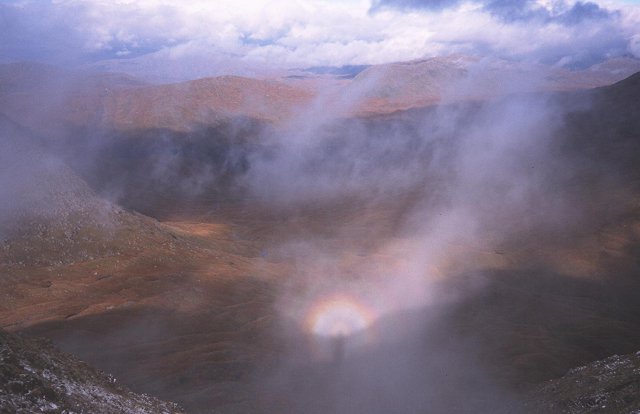

A summary of rainbowlike phenomena was provided in Scientific American in 1977, and states: Modern theories of light, first described by Henri Poincaré in 1887, are able to explain the phenomenon of glories through the complex angular momentum (rotation) of the electromagnetic field of a light wave, and do not need quantum theories. Theory A solar glory and Brocken spectre from Crib Goch in 2008 In Goethe's Faust, the Brocken is called the Blocksberg and is the site of the Witches' Sabbath on Walpurgis Night. Giant shadows that seemed to move by themselves due to movement of the cloud layer (this movement is another part of the definition of the Brocken spectre), and that were surrounded by glories, may have contributed to the reputation the Harz mountains hold as a refuge for witches and evil spirits. Because the peak is above the cloud level and the area is frequently misty, conditions conducive to casting a shadow on a cloud layer are common. The name derives from the Brocken, the tallest peak of the Harz mountain range in Germany. When viewed from a mountain or tall building, glories are often seen in association with a Brocken spectre, also called Mountain spectre, the apparently enormously magnified shadow of an observer, cast (when the sun is low) on clouds below the mountain on which the viewer is standing.


Main article: Brocken spectre A solar glory and Brocken spectre This is sometimes called The Glory of the Pilot. In the latter case, if the plane is flying sufficiently low for its shadow to be visible on the clouds, the glory always surrounds it. Outdoor glories are commonly observed from aircraft. Because this point is diametrically opposite to the sun's (or moon's) position in the sky, it usually lies below the observer's horizon except at sun (or moon) rise and set. Like a rainbow, outdoor glories are centred on the antisolar (or, in case of the moon, antilunar) point, which coincides with the shadow of the observer's head. "Glories can be seen on mountains and hillsides, from aircraft and in sea fog and even indoors." In the right conditions, a glory and a rainbow can occur simultaneously. The angular size of the inner and brightest ring is much smaller than that of a rainbow, about 5° to 20°, depending on the size of the droplets. The rings are rarely complete, being interrupted by the shadow of the viewer. Glories arise due to wave interference of light internally refracted within small droplets.ĭepending on circumstances (such as the uniformity of droplet size in the clouds), one or more of the glory's rings can be visible. Due to its appearance, the phenomenon is sometimes mistaken for a circular rainbow, but the latter has a much larger diameter and is caused by different physical processes. The glory consists of one or more concentric, successively dimmer rings, each of which is red on the outside and bluish towards the centre. The position of the glory's centre shows that the observer was in front of the wings.Ī glory is an optical phenomenon, resembling an iconic saint's halo around the shadow of the observer's head, caused by sunlight or (more rarely) moonlight interacting with the tiny water droplets that comprise mist or clouds. Optical phenomenon that resembles an iconic saint's halo about the shadow of the observer's head


 0 kommentar(er)
0 kommentar(er)
